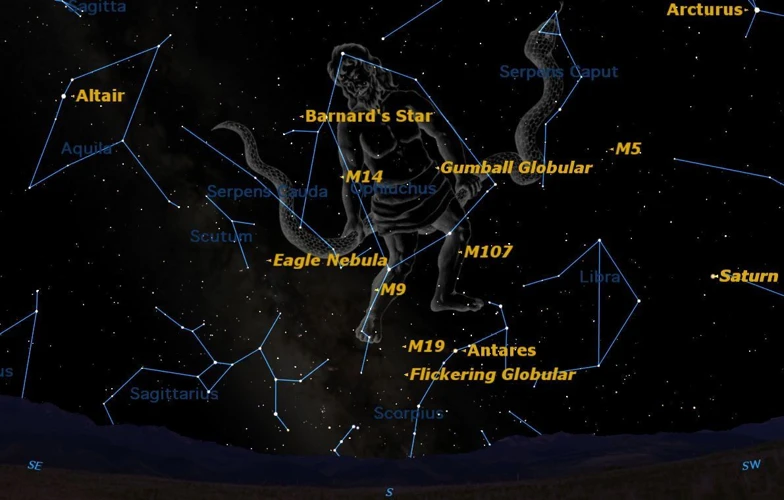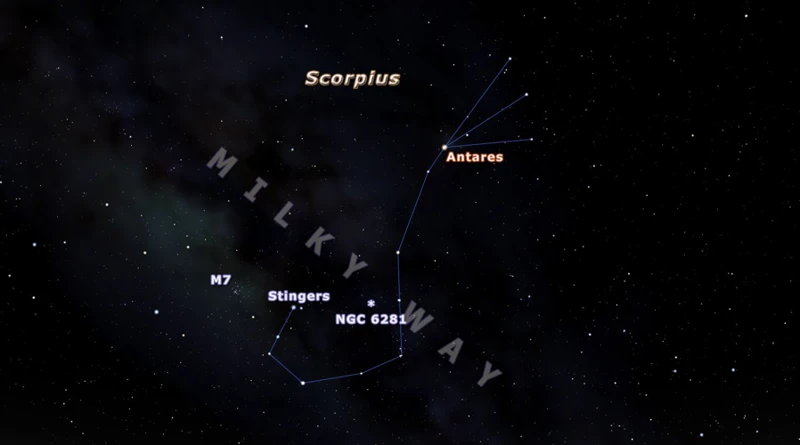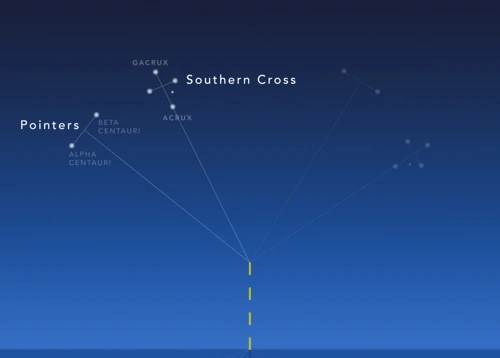The night sky has always held a sense of mystery and wonder, captivating the imaginations of stargazers throughout history. For those in the southern hemisphere, the night sky offers a unique and enchanting display of constellations that may not be visible from other parts of the world. Navigating the southern night sky can be an adventure in itself, as it requires a different set of celestial landmarks. In this article, we will explore tips and techniques for spotting and identifying southern constellations, from the iconic Southern Cross (Crux) to the majestic Centaurus and the intricate Carina. So, grab your binoculars and let’s embark on a cosmic journey through the mesmerizing expanse of the southern night sky.
Understanding the Southern Night Sky

Understanding the Southern Night Sky is a fascinating journey into the celestial wonders that adorn the southern hemisphere. The first step in understanding the southern night sky is to familiarize oneself with the unique characteristics of this celestial landscape. Unlike their northern counterparts, the southern constellations offer a different perspective and a plethora of new stars to explore. One of the most iconic features of the southern sky is the Southern Cross (Crux), a prominent and easily recognizable constellation that has been used for centuries as a navigational aid for sailors and explorers. Another awe-inspiring constellation is Centaurus, represented by the mythical centaur that highlights the grandeur and beauty of the southern night sky. Carina, meaning “the keel” in Latin, is another constellation that showcases the intricate stellar formations that can be found in the southern hemisphere. Understanding the southern night sky also allows stargazers to appreciate the mesmerizing constellation of Scorpius, with its scorpion shape and multitude of stars. To delve deeper into the origins and historical accounts of these southern constellations, one can explore the connecting dots to discover the rich cultural significance and tales associated with each constellation. Additionally, the southern night sky holds a treasure trove of deep-space wonders, from dazzling nebulae to distant galaxies, offering a celestial feast for astronomers and stargazers alike. Exploring these celestial gems in the southern sky reveals the vastness of the universe and the boundless wonders that await discovery. Understanding the southern night sky is not merely an exercise in star-spotting, but a gateway to appreciating the beauty and mystery of our universe.
Identifying Southern Constellations

Identifying Southern Constellations is an exhilarating endeavor that allows stargazers to appreciate the wonders of the southern night sky. The key to identifying these celestial formations lies in understanding their unique patterns and characteristics. The Southern Cross (Crux) stands out as a prominent constellation in the southern hemisphere, recognizable by its distinctive cross shape. Another captivating constellation is Centaurus, adorned with its bright stars and rich mythological history. Carina, known as “the keel,” boasts intricate stellar formations that captivate the imagination. Scorpius, resembling a scorpion, is a constellation that showcases a multitude of stars and offers a celestial spectacle. Exploring the origins and historical accounts of these southern constellations provides a deeper appreciation for their cultural significance, and for those who seek to delve into the wonders of deep space, the southern night sky holds a multitude of treasures waiting to be discovered. Whether it’s connecting the dots to reveal the stories behind these constellations or marveling at the celestial gems of the southern hemisphere, identifying southern constellations is a gratifying journey through the mysteries and grandeur of the night sky.
1. The Southern Cross (Crux)
The Southern Cross (Crux) is one of the most recognizable and iconic constellations in the southern night sky. Consisting of four bright stars that form a cross shape, the Southern Cross has been used for centuries as a navigational tool.
Formation: The formation of the Southern Cross is distinct and easily identifiable. It consists of four primary stars: Alpha Crucis (Acrux), Beta Crucis (Mimosa), Gamma Crucis (Gacrux), and Delta Crucis. These stars create the shape of the cross, with Acrux marking the bottom of the cross and Gacrux marking the top. Mimosa, known for its vivid blue color, is the second brightest star in the Southern Cross.
Navigation: Historically, the Southern Cross played a crucial role in navigation for sailors in the southern hemisphere. Due to its distinctive shape and visibility throughout the year, it served as a reliable guide for determining the direction south. By aligning the long axis of the cross with the point where it intersected the horizon, sailors could determine their latitude and navigate accurately.
Cultural Significance: The Southern Cross holds deep cultural and historical importance in various societies. It has been used as a symbol in national flags, such as in the flags of Australia and New Zealand. Indigenous cultures in Australia, South America, and other parts of the southern hemisphere have stories and legends associated with the Southern Cross, often attributing mythical significance to its stars.
Additional Information: Exploring the Southern Cross can lead to a deeper understanding of the origins and historical accounts of southern constellations. Discovering the legends and stories connected to the Southern Cross through the rich tapestry of cultural heritage can provide valuable insights into the significance attributed to these celestial formations. For those seeking to explore more deep-space treasures in the southern night sky, there is a wealth of celestial gems awaiting discovery. These captivating features include stunning nebulae, distant galaxies, and other astronomical wonders that highlight the majesty of the southern hemisphere. To delve deeper into the lore and historical accounts of southern constellations, you can follow the link to explore the connecting dots that unravel the fascinating stories behind these celestial marvels.
2. Centaurus
Centaurus is a constellation that graces the southern night sky with its majestic presence. Named after the mythical centaur, Centaurus is one of the largest constellations in the sky, occupying a significant portion of the southern hemisphere. It is best seen during the months of April to July, when it reaches its highest point in the sky. One of the striking features of Centaurus is the bright star Alpha Centauri, which is the closest star system to our own solar system. This triple star system consists of three stars: Alpha Centauri A, Alpha Centauri B, and Proxima Centauri. Proxima Centauri holds a special place in astronomical research as it is the closest known star to Earth, located approximately 4.24 light-years away. In addition to Alpha Centauri, Centaurus is also home to other notable stars, such as Beta Centauri and Omega Centauri, the latter being one of the largest and brightest globular clusters in the Milky Way galaxy. The constellation also contains several fascinating deep-space objects, including NGC 5128, also known as Centaurus A, a peculiar galaxy with a prominent dust lane, and NGC 4945, a spiral galaxy similar to our own Milky Way. Exploring Centaurus’s celestial gems provides a glimpse into the vastness of the universe and the wonders that lie beyond our own galaxy. To learn more about the origins and historical accounts of Centaurus and other southern constellations, one can delve into the fascinating stories and cultural significance by following the link to connecting the dots of southern constellations. Alternatively, for those yearning to discover more extraordinary deep-space treasures in the southern night sky, the link to deep-space treasures in southern constellations offers a glimpse into the awe-inspiring cosmic wonders that await exploration in the southern hemisphere.
3. Carina
Carina is a constellation that graces the southern night sky with its celestial elegance. Named after the Latin word for “the keel,” Carina represents the keel of the legendary ship Argo Navis, which was divided into three separate constellations in the 18th century. This constellation is home to a plethora of captivating celestial objects and deep-sky wonders that hold the fascination of astronomers and stargazers. One of the most famous features of Carina is the Eta Carinae Nebula, a colossal cloud of gas and dust that stretches over 100 light-years and contains one of the most massive stars known to humanity. The nebula’s vibrant colors and intricate formations make it a favorite target for astrophotographers. Another notable sight within Carina is the Southern Pleiades, an open star cluster reminiscent of its northern counterpart, the Pleiades. This cluster is composed of a group of young, hot stars surrounded by glowing gas and dust. Carina also houses the Keyhole Nebula, a dark cloud of gas and dust that obscures parts of the Carina Nebula, adding an air of mystery to this celestial gem. The beauty and splendor of Carina make it a must-see for anyone exploring the wonders of the southern hemisphere’s night sky. To learn more about the celestial gems that adorn the southern night sky, you can delve into the fascinating world of southern hemisphere celestial gems, where countless marvels await discovery.
4. Scorpius
Scorpius is a captivating constellation that graces the nighttime sky in the southern hemisphere. Its distinct shape resembling a scorpion makes it easily recognizable and a favorite among stargazers. Located near the center of the Milky Way, Scorpius offers a breathtaking view of numerous stars and celestial objects. The brightest star in Scorpius is Antares, often referred to as the “heart” of the scorpion. This red supergiant star shines brightly and adds to the beauty of the constellation. One of the standout features of Scorpius is its incredible array of deep-sky treasures. Within its boundaries, there are numerous nebulae, star clusters, and even a globular cluster. One of the most famous objects within Scorpius is the intricate and sprawling Scorpius X-1, a binary star system that is also one of the strongest X-ray sources in the sky. Exploring the celestial gems within Scorpius provides stargazers with a fascinating glimpse into the vastness and diversity of the southern skies. To embark on a cosmic journey through the southern hemisphere and explore more celestial gems, check out the comprehensive guide to Southern Hemisphere Celestial Gems. Whether you’re an experienced astronomer or a curious beginner, Scorpius and its celestial companions offer a wealth of sights to marvel at and discover in the southern night sky.
Tips for Spotting Southern Constellations

When it comes to spotting southern constellations, there are several tips that can help enhance your stargazing experience. First and foremost, consider the time and season, as different constellations become visible at different times throughout the year. Research the optimal viewing times for specific constellations and plan your stargazing outings accordingly. Secondly, finding dark sky locations away from light pollution is crucial for optimal visibility. Seek out remote areas, national parks, or observatories where the night sky is not drowned out by artificial lights. Thirdly, utilize stellar navigation apps that can enhance your ability to locate and identify constellations. These apps provide real-time information, interactive sky maps, and even augmented reality features to guide your stargazing adventures. By following these tips, you can improve your chances of spotting and identifying the mesmerizing southern constellations that adorn the night sky.
1. Time and Season
When it comes to spotting southern constellations, understanding the correct time and season is crucial. The position of the constellations in the night sky changes throughout the year due to Earth’s orbit around the Sun. To maximize your chances of observing specific southern constellations, it’s important to know when they are visible and at what times.
One way to determine the best time for stargazing is to consult a star chart or astronomy app that provides information on the rising and setting times of constellations. These resources can also indicate the months when certain constellations are most prominent. For example, the Southern Cross (Crux) is easily visible during the southern hemisphere’s winter months, while Centaurus dominates the night sky during the autumn and spring seasons.
Understanding the correlation between time, season, and the visibility of southern constellations enhances your chances of successfully spotting them. By planning your stargazing sessions according to the best viewing times and seasons, you can optimize your celestial experience and enjoy the beauty of the southern night sky to the fullest.
2. Dark Sky Locations
Finding dark sky locations is crucial for optimal stargazing and spotting southern constellations. Light pollution from cities and towns can greatly diminish the visibility of celestial objects, making it difficult to fully appreciate the beauty of the night sky. Fortunately, there are numerous dark sky locations around the world that offer ideal conditions for observing the southern constellations. One exceptional dark sky location is the Aoraki Mackenzie International Dark Sky Reserve in New Zealand. This reserve, nestled in the South Island, boasts exceptionally low light pollution and provides breathtaking views of the southern night sky. Another notable dark sky location is the NamibRand Nature Reserve in Namibia. This vast expanse of desert offers minimal light pollution and a mesmerizing backdrop for stargazing. Chile’s Atacama Desert is yet another remarkable dark sky location, home to various observatories and offering pristine conditions for observing southern constellations. When searching for dark sky locations, it is important to consider factors such as proximity to major cities, elevation, and weather conditions. By venturing to these dark sky locations, stargazers can escape the glow of artificial light, allowing them to fully immerse themselves in the wonders of the southern night sky and appreciate the splendor of the constellations above.
3. Stellar Navigation Apps
When it comes to spotting and identifying southern constellations, technology can be a valuable ally. That’s where stellar navigation apps come into play. These handy applications provide an interactive and immersive experience, helping both beginners and seasoned stargazers navigate the southern night sky with ease. Stellar navigation apps utilize augmented reality and GPS technology to overlay a virtual sky map onto the real sky, allowing users to point their devices towards a specific constellation and instantly discover its name and relevant information. These apps often include features like constellation identification, star charts, and detailed information about individual stars and celestial objects. Some apps even offer real-time updates on the position and visibility of planets, satellites, and other astronomical events. Whether you’re in a remote area or a bustling city, stellar navigation apps can help you overcome light pollution and other visibility challenges, making it easier to locate and appreciate southern constellations. Some popular stellar navigation apps include [insert relevant anchor text for stellar navigation apps] that provide comprehensive and user-friendly interfaces for seamless stargazing experiences. With these apps at your fingertips, you can truly unlock the wonders of the southern night sky and embark on a cosmic journey right from the palm of your hand.
Constellation Viewing Etiquette
Constellation viewing etiquette is important for ensuring a respectful and enjoyable experience for all stargazers. Firstly, it is advisable to use red lights when navigating and observing the night sky. Red lights are less likely to disturb the eyes’ adaptation to darkness, allowing for better visibility of the constellations. Avoid using white lights or flashlights, as they can disrupt the natural darkness and hinder the ability to spot faint stars. Secondly, it is crucial to minimize light pollution. Choose a location away from urban areas or other sources of artificial light, as excessive illumination can obscure the visibility of constellations. Embracing the darkness allows for a clearer view of the stars and a more immersive stargazing experience. Finally, consider utilizing stellar navigation apps or star charts to help identify and locate specific constellations. These tools can provide valuable information and enhance the overall enjoyment of observing the southern night sky. By following these simple guidelines, stargazers can fully appreciate the beauty of the constellations while respecting the celestial environment and fellow observers.
1. Use Red Lights
Using red lights is an essential practice when observing the night sky and ensures the preservation of the viewer’s night vision. Regular white light interrupts the natural adaptation of the eyes to the darkness, making it harder to see faint stars and constellations. Red lights, on the other hand, have a longer wavelength and do not affect night vision as significantly. The use of red lights allows stargazers to navigate their surroundings without losing the ability to see celestial objects clearly. It is recommended to use a red flashlight or cover a standard flashlight with a red filter to achieve the desired effect. By utilizing red lights, astronomers and amateur stargazers alike can fully immerse themselves in the beauty of the night sky while maintaining optimal visibility and preserving the natural dark environment.
2. Avoid Light Pollution
Avoid Light Pollution
1. Choose Dark Sky Locations: When searching for the ideal spot to observe southern constellations, it is crucial to find an area with minimal light pollution. Light pollution refers to the excessive artificial lighting that obstructs our view of the night sky. Look for locations that are away from cities or towns where ambient light is minimal. National parks, remote countryside areas, or designated dark sky reserves are excellent options for experiencing pristine night skies.
2. Shield Light Sources: To minimize light pollution, it is essential to shield any outdoor lights. Install shielded fixtures or place covers on existing lights to direct the illumination downward and prevent it from scattering into the atmosphere. This way, the impact on the night sky is significantly reduced, allowing for better visibility of the southern constellations.
3. Use Low-Intensity Lighting: If you need some light for navigation or safety purposes during your stargazing session, choose low-intensity lighting options. Red LED lights are particularly suitable because they have a longer wavelength and are less likely to interfere with night vision compared to white or blue lights. Red light also preserves the darkness of the night sky, allowing for a more immersive stargazing experience.
4. Raise Awareness: Educate others about the importance of reducing light pollution and its effects on the night sky. Encourage neighbors, local communities, and authorities to invest in environmentally friendly outdoor lighting and adopt dark sky-friendly practices. By spreading knowledge and raising awareness, we can collectively contribute to preserving the beauty of the southern night sky and its constellations for generations to come.
Remember, by avoiding light pollution, we not only enhance our ability to spot and identify southern constellations, but we also contribute to the conservation of our natural environment and the reduction of wasteful energy consumption. So, make a conscious effort to protect the darkness and marvel at the celestial wonders above.
Conclusion
In conclusion, navigating the southern night sky is an awe-inspiring experience that allows us to connect with the vastness of the universe and appreciate the celestial wonders that adorn the southern hemisphere. By understanding the unique characteristics of the southern night sky and familiarizing ourselves with the prominent southern constellations, such as the Southern Cross (Crux), Centaurus, Carina, and Scorpius, we can embark on a cosmic journey that transcends time and space. Through the use of red lights, avoiding light pollution, and utilizing stellar navigation apps, we can enhance our ability to spot and identify these magnificent southern constellations. It is important to remember to maintain proper constellation viewing etiquette to ensure a respectful and unobstructed experience for all stargazers. Whether you are a seasoned astronomer or a novice sky enthusiast, the southern night sky offers a mesmerizing display of beauty and wonder that is waiting to be explored. So, venture into the darkness, gaze upward, and let the southern constellations guide you on a celestial adventure like no other.
Frequently Asked Questions
1. How can I recognize the Southern Cross in the night sky?
To identify the Southern Cross, look for four bright stars arranged in the shape of a kite or a cross. The two stars at the top of the cross are called the “Pointer Stars” as they point towards the cross. This iconic constellation can be found in the southern hemisphere and is a prominent feature of the southern night sky.
2. What is the best time to spot southern constellations?
The best time to view southern constellations is during the autumn and winter months, as they are most visible during these seasons. However, the exact times may vary depending on your location and the specific constellation you are trying to observe. Consult a star chart or a stargazing app for the most accurate information.
3. Can I see southern constellations from the northern hemisphere?
While some southern constellations may be visible from certain locations in the northern hemisphere, they will appear low on the horizon and may not be as prominent as they are in the southern hemisphere. It is best to travel to a southern location or use virtual tools to explore the southern sky in detail.
4. Are there any notable deep-space objects within southern constellations?
Absolutely! Southern constellations are home to many fascinating deep-space objects. For example, the Carina Nebula in the constellation Carina is one of the largest and brightest nebulas in the night sky. The Jewel Box Cluster in the constellation Crux is another stunning sight, showcasing a vibrant collection of stars. Explore the southern sky to discover these celestial treasures.
5. How can I locate Centaurus in the southern night sky?
To find Centaurus, look for a constellation that resembles a centaur holding a spear. It lies in the southern sky, and its brightest star, Alpha Centauri, is one of the closest stars to Earth. You can use other neighboring constellations, such as Crux or Carina, as reference points to locate Centaurus.
6. What are some popular dark sky locations for stargazing in the southern hemisphere?
There are several popular dark sky locations in the southern hemisphere, such as the Atacama Desert in Chile, Lake Tekapo in New Zealand, and NamibRand Nature Reserve in Namibia. These remote areas away from light pollution provide ideal conditions for observing and appreciating the beauty of the southern night sky.
7. Are there any stellar navigation apps that can help me identify southern constellations?
Absolutely! There are several stellar navigation apps available that can make stargazing and identifying southern constellations easier. Apps like SkyView, Star Walk, and Stellarium provide real-time information about the night sky, including the location and details of southern constellations.
8. Why is it important to use red lights when observing southern constellations?
Using red lights when observing southern constellations is important because red lights have a lower impact on your night vision compared to white lights. Red lights allow your eyes to adapt to the darkness and make it easier to see faint stars and details in the night sky without disrupting your vision.
9. How can I avoid light pollution when stargazing in the southern hemisphere?
To avoid light pollution when stargazing in the southern hemisphere, it is best to choose remote locations away from cities and urban areas. National parks, nature reserves, and designated dark sky areas offer darker skies and better visibility. Additionally, using light shields or filters on flashlights and avoiding the use of bright screens or devices can help minimize light pollution.
10. Can I use a telescope to observe southern constellations?
Absolutely! Using a telescope can enhance your viewing experience and allow you to explore the intricate details of southern constellations and deep-space objects. However, it’s important to familiarize yourself with the telescope’s usage instructions and align it properly to navigate the southern sky.








